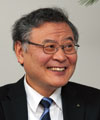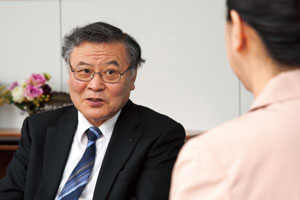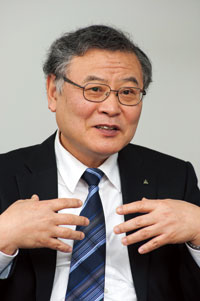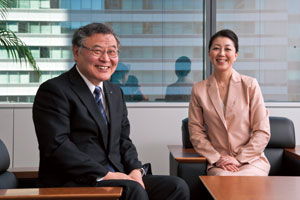 |
|||
|
|
|||
|
View from the Top Vol. 9, No. 5, pp. 1–5, May 2011. https://doi.org/10.53829/ntr201105tp1  Motivated, Persistent, and Resolute–– Taking on the Challenges of New Technologies and Customer Needs with a Broad PerspectiveOverviewNTT DATA CORPORATION is known for promoting cloud computing technology, which is now attracting considerable attention, and the further globalization of Japanese enterprises. Wondering how top executives at the company with their many years of technical experience view present conditions, we asked Shinichi Yamada, Executive Vice President and Representative Director, to tell us about current business efforts at NTT DATA and the role that the company should play in society. Combining advanced technologies and extensive knowledge to look ahead to the future—This year marks the halfway point of NTT DATA’s Medium-Term Management Policy. How do you assess its progress? NTT DATA seeks to become No. 1 in customer satisfaction as a leading-edge innovator in line with its Medium Term Management Policy, which targets sales of 1.5 trillion yen in fiscal year 2012, and the goal of becoming one of the top-five global IT (information technology) service companies. In this regard, our efforts are achieving results, as reflected by an increase in overseas sales, but if we turn our attention to the Japanese market, I feel that the IT industry itself is slightly contracting as customers become more concerned with cost reductions. I don’t think that we can simply blame the economy for our problems here, but it is true that new IT investment by customers has not yet recovered in Japan and that even at NTT DATA we are doing our best to just maintain current business levels. Sometimes it feels like we will never get back to a growth trend, but despite these difficulties, we are getting some results thanks to the hard work of our employees. —What areas do you feel are contracting? One good example is hardware, where technical innovation is raising performance and lowering prices. This trend toward commoditization is also happening to networks, where prices likewise seem to be dropping every year. In the past, network scale would inflate every time a system was upgraded, which drove up sales. Nowadays, however, these networks are simply being maintained, which results in a contracting environment. To give another example, NTT DATA has also been involved in software development, and the developers here have been Japanese engineers. However, once Chinese engineers enter this field, we can expect prices to collapse the same as they did in the manufacturing industry. This lack of IT investment and sluggish market expansion in Japan is making for severe price competition, and even when orders are received, it is not uncommon for them to come with very harsh conditions. Expanding sales under these conditions is therefore difficult to say the least, but nevertheless I want to set the targets and take on the challenges of overcoming these difficulties. —Is there any approach that could lead to a breakthrough? Yes, of course, and we are actually working on this from many angles. One way is to lower costs such as by expanding offshore development. And it is also important that we not only convert our customers’ businesses to IT but also help them to expand their businesses through optimal use of IT. In other words, it is vital that we create added value and new markets. Key tools here are cloud computing, machine-to-machine (M2M) communication, and business intelligence from a technical viewpoint and outsourcing from a business-model viewpoint. In terms of organization, robotics and business intelligence are being pursued by the Robotics Integration Promotion Office and Business Intellige-nce Promotion Center, respectively, set up in NTT DATA’s Research and Development Headquarters. Today, smart grids and structure monitoring are attracting attention as social infrastructures making use of information and communication technology (ICT). We should think of robotics as a technology that is essential to the construction of these social infrastructures since it can be used to collect and analyze all kinds of information from sensor networks and feed the analysis results back to the real world. In other words, robotics can merge cyber space and real space. For example, it can be used to monitor traffic and control signals and measure structural fatigue in bridges in real time and establish a repair plan. We are working to open up this field of controlling the real world through ICT. Of increasing importance here is business intelligence as a means of analyzing and utilizing the huge amount of information obtained from such systems and providing useful output. I am getting good reactions to the use of robotics, and our employees keenly feel that we must do something. This also holds true for M2M. However, in Japan, customers often view ICT only in terms of cost, without realizing that it can be a valuable tool for expanding business and even for changing society. In the past, ICT was often approached in the context of “How can we develop it?” but from here on, I believe that we must think of it in the context of “How can we use it to best effect?” —What are your thoughts on cloud computing? As you know, the NTT Group is a service creation enterprise, and it is well aware that the cloud is a crucial factor in the future expansion of services. NTT was originally involved in services that provide access to mainframe computers over the network (DRESS/DEMOS), even as far back as the Nippon Telegraph and Telephone Public Corporation era, which ended with its privatization in 1985. These services themselves contracted as technical innovation brought the cost and size of computers down, but NTT has nevertheless continued to provide shared-use systems to financial institutions. What I’m trying to say here is that, while the technology itself may change, our experience with the cloud model runs deep. On the other hand, the services that NTT DATA has long been providing have been directed toward particular groups, and we have yet to tackle cloud services for the general public as provided by Amazon.
—As you have been involved with the cloud model longer than most, you probably have some visions. Yes, I think our experiences and know-how are very valuable for NTT DATA’s efforts to expand its business in cloud computing. One idea is a cloud directed toward a group of enterprises with common interests as in the case of a supply chain. In short, we envision clouds directed toward specific communities. I believe that coordinating the needs of many stakeholders and incorporating them in services is a particular specialty of NTT DATA. Another idea is to convert the assets of the NTT DATA Group into a cloud platform to give us a competitive advantage. For example, NTT DATA Intramart is the No. 1 workflow platform in Japan; this was achieved through tie-ups with business application vendors and sales partners. In this way, NTT DATA provides a space called an Intramart cloud, and by having our partners develop a variety of services and applications, we can achieve a win-win-win relationship among NTT DATA, partners, and users. And in the mainframe field, we are also converting NTT DATA’s assets into a cloud. Migration to a cloud can be promoted by providing a base called a COBOL* cloud and preparing a migration path from the legacy system to the cloud platform. In addition to the above, NTT DATA was quick to make use of Hadoop open source software for distributed processing of large quantities of data. This software framework is attracting interest in the business intelligence field as a means of providing new added value to a customer’s business, and we are providing it as a cloud service. From the viewpoint of the NTT Group, however, the cloud has an additional meaning. The main role of ICT so far has been to make the processing of business forms and exchanges with customers more efficient, but there is now a big movement toward using ICT to achieve a better society in a variety of areas such as medicine, education, social welfare, and traffic control in the manner of, for example, cyber-physical systems. From here on, as this role of ICT rapidly expands, it will become increasingly important to make application creation more efficient and make application creation mechanisms easier to access. The cloud looks to become a key mechanism for creating these new applications. We have also been saying to our colleagues at NTT Laboratories in strategy meetings held over the last few years that cloud computing will become increasingly important in the years to come, and we are beginning to collaborate with them in this regard. —Please tell us about NTT DATA’s approach to OSS. There are three reasons for our involvement in open source software (OSS). The first reason, of course, is lower costs. Although hardware performance is rising as the cost of hardware is dropping, as I mentioned earlier, the cost of software is not dropping all that much. Using OSS to construct software products can reduce costs below those of using commercially available software. This license-free advantage takes on even more value in the case of cloud computing. Reducing costs, however, is not the main reason for using OSS. The second and more important reason is to avoid vendor lock-in. From the start, NTT DATA has advocated a multi-vendor approach and has been praised for doing so. Here, the use of OSS is indispensable to a truly vendor-free environment. At the same time, we must set up our own system to support the analysis and correction of software faults, at least for major OSS products. Doing so will provide a number of advantages, including the long-term, reliable use of a system not only for us but also for customers and lower costs over the system’s lifetime. We have been working with the NTT Holding Company at the NTT Open Source Software Center on this, but I would like to expand the scope of this collaboration. The third reason, which is actually more of a secondary effect, is the training provided to NTT DATA engineers by reading and understanding the source code themselves. The most important asset (resource) in an IT firm is its people. Open source software represents the fruit of the skills and intellect of software developers around the world, which is why it can progress so rapidly. Catching up in this way or making a contribution to OSS is more useful than anything else for improving the skills of our software engineers. Looking forward, I would like to promote collaboration in OSS use between NTT DATA itself and overseas companies in the NTT DATA Group.
Exploiting our strengths and advancing together—How is NTT DATA approaching globalization? As I touched upon earlier, overseas sales have reached the 100-billion-yen level mainly through mergers and acquisitions. The NTT DATA Group already has 20,000 employees working overseas. The number of global projects is actually increasing with a focus on Japanese customers, and the opportunities for providing consultations on global support are increasing steadily. To meet our customers’ expectations in this environment, I believe that we must standardize and unify the work processes and quality level among the group companies. Of course, each company has its particular forte and it would not be beneficial to overdo this and prune off its strong points. Nevertheless, it is important to share the NTT DATA Way, as both implicit and formal knowledge, among the companies so that a customer whose business spans a number of countries can feel at ease entrusting its work to the NTT DATA Group. My responsibilities also include offshore development companies. Our emphasis up to now has been the provision of offshore services to Japanese firms, but we now need to set up a mechanism for global delivery that can perform development work at optimal locations throughout the world. There is also a need to create solutions and products that can be sold on a global basis. In technology development, we have begun to share information about the skills, solutions, and products of each group company and to pursue global research and development (R&D). The aim here is to consolidate the ideas coming out of the various companies so that we can move forward as the NTT DATA Group. Our global R&D promotional base will be moving to North America (Silicon Valley) next fiscal year. Of course, we will continue to cooperate with NTT Laboratories of the NTT Holding Company more than ever, but we will move forward while maintaining a balance between both approaches to R&D. Incidentally, we have begun research in collaboration with NTT Laboratories on a high-accuracy multilingual machine translation system for automatically translating Japanese manuals and design specifications into English, Chinese, and other languages. Needless to say, it is important that we connect these new endeavors to results. Although we are also tackling R&D with a view to the future, obtaining results will be difficult unless we reassess our R&D targets every year or even every quarter. In a world of constant change, I believe that it is more important to accurately assess what is right in front of our eyes than to look three years into the future.
Seeing the big picture—Under these circumstances, it appears that you need the ability to change systems in response to changes in the business world as well as foresight in research. At present, no one really knows whether the projects that we are undertaking are the right projects, so honestly speaking, it is extremely difficult to say what viewpoint or approach is the best. The history of IT is said to be in its infancy, but it’s already been several decades since the mainframe era, and technical innovations keep on coming. In the past, NTT conducted multimedia experiments on an Information Network System (INS), video-on-demand, and other new systems; today, we have reached the point where optical fiber can reach homes and TV can be viewed over optical fiber cables. Trials such as these were carried out not only in Japan but also overseas. It is said that life goes in cycles, and trends like these can be found just about anywhere, so if we study past cases, I think we can surmise that the future will evolve in a similar manner and make predictions to some extent. In this way, we pursue various types of business while pondering whether we fully understand what the customer is thinking and whether the test phases for new products and services are advancing efficiently. To continue growing, NTT DATA must gain a foothold in new markets while efficiently constructing and operating systems in the current market. Both are essential and achieving a balance between the two is important. However, it is not always possible to move forward with good balance between these two requirements; there will sometimes be a bias toward one or the other, but it may not hurt to go back and forth between these two modes of action. What is important here is not giving up! Moreover, advancing together as a team requires frequent discussion. When I served as manager of the Research and Development Headquarters, I made an effort to set aside time to talk to employees. Everyone would like to do the things they want to do, but that is not always possible. That’s why talk is crucial to objectively perceive, clarify, and share the why, when, and what of work. In research in particular, one tends to think in terms of what it is that one personally wants to accomplish, but aligning oneself with other people can broaden one’s horizons and lead to great results. About fifteen years ago, I had the opportunity to spend two years in Silicon Valley in California, and I noticed that the people I encountered there behaved much in this way. They conducted joint research with the people that needed technology, that is, with customers, and solved problems together, which I think is a great shortcut to results. Open innovation is a trendy phrase nowadays, but I would like to see researchers approach their work in this way.
Interviewee profileCareer highlightsShinichi Yamada entered Nippon Telegraph and Telephone Public Corporation (now NTT) in 1977. Since the founding of NTT DATA CORPORATION in 1988 as a spin-off company, he has held various positions including Director of Business Development Sector (2004), Director and Senior Vice President of the System Platforms Sector (2005), and Executive Vice President of the System Platforms Sector and Research and Development Headquarters (2007). He has served as Executive Vice President, Representative Director, and CTO of NTT DATA CORPORATION and President of the Solutions & Technologies Company since June 2009. |
|||










